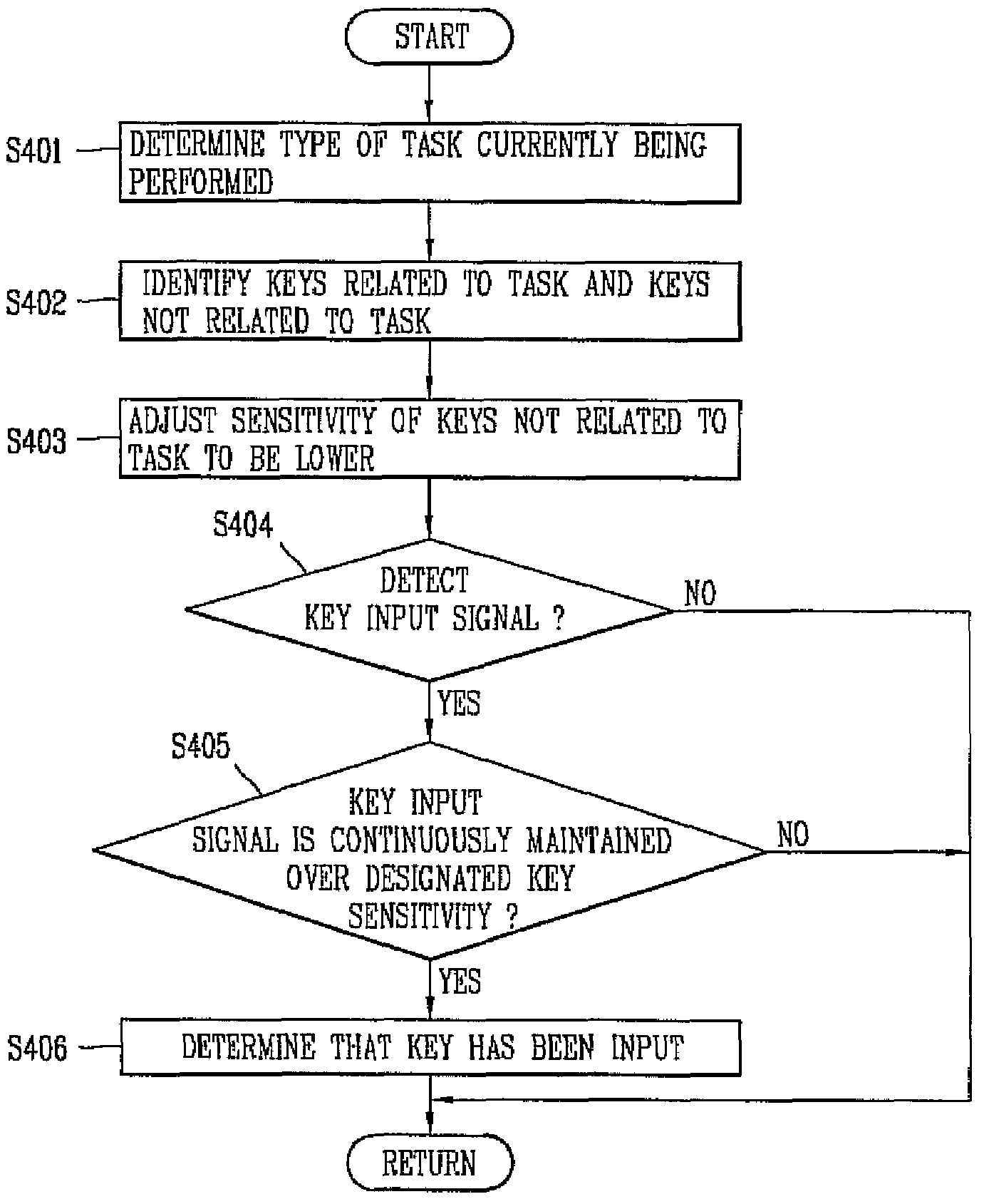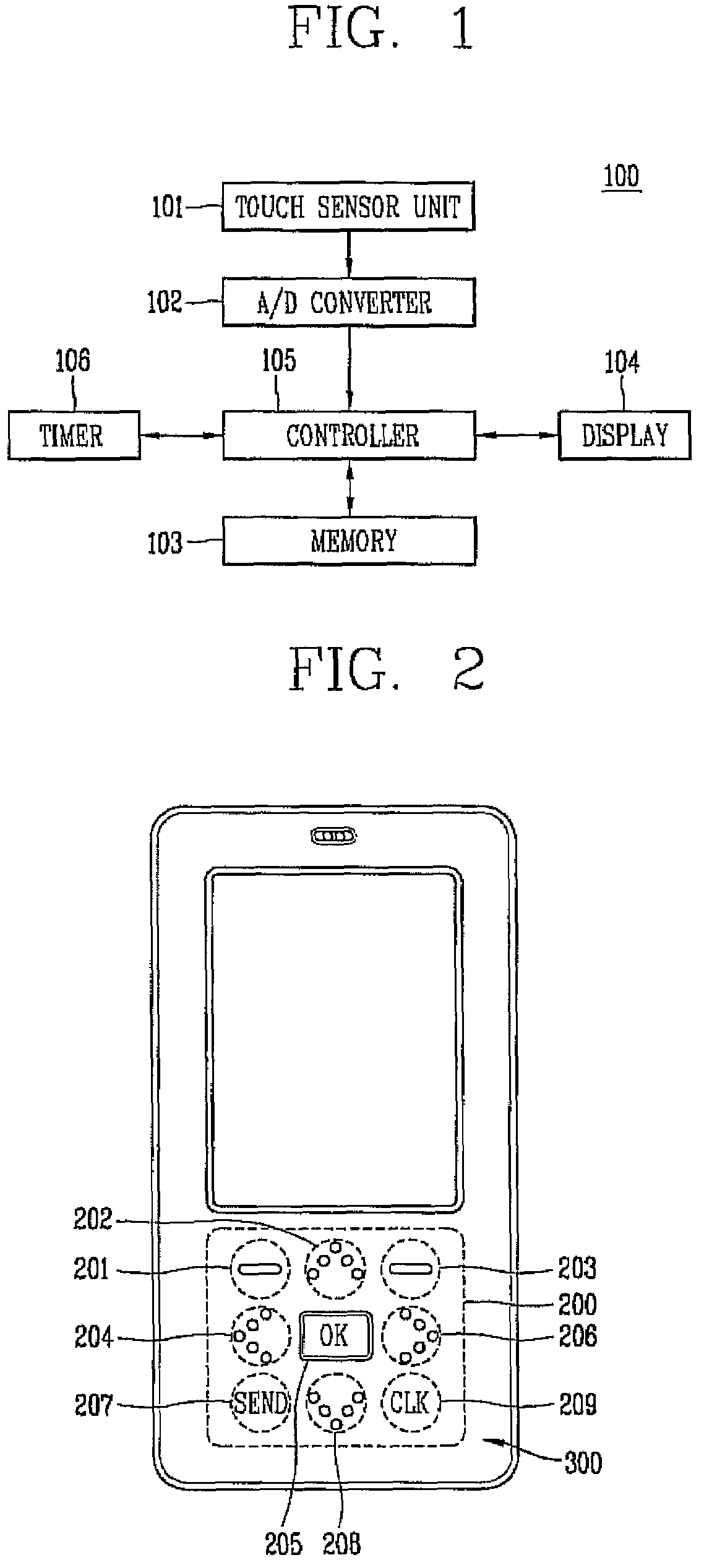Mobile communications terminal having key input error prevention function and method thereof
a mobile communication terminal and key input technology, applied in the direction of coding, pulse technique, instruments, etc., can solve the problems of unintended key function input, touch-type keypad, excessive force applied to the user's finger upon pressing a key, etc., to prevent a key input error
- Summary
- Abstract
- Description
- Claims
- Application Information
AI Technical Summary
Benefits of technology
Problems solved by technology
Method used
Image
Examples
first embodiment
[0056]The tasks represented in FIG. 3 may include phone number registration, text message transmission, menu selection and setup, a game and multimedia play among tasks performable in the mobile communications terminal. The key input error prevention algorithm according to the present invention is adapted to prevent the key input error by setting priorities for each key and determining a key having a higher priority among two or more keys input as the input key.
[0057]Methods for setting priority will now explained with reference to the key arrangement illustrated in FIG. 4. As illustrated in FIG. 4, the keys are arranged in three lines and three columns with navigation keys located in the second column of the first line, the first column of the second line, a third column of the second line and the second column of the third line.
[0058]In a first method for setting priority when two keys located in different lines are simultaneously input, such as in the first line and the second li...
second embodiment
[0064]A key input error prevention algorithm in accordance with the present invention prevents the key input error by determining the key input that a user desires according to a capacitance level of a signal generated when touching a keypad region 201-209.
[0065]FIG. 6 illustrates a lateral end portion of typical user's finger. Generally, an end of a person's finger, as illustrated in FIG. 6, has an approximately oval shape and particularly, a center portion 601 of a finger has a convex shape.
[0066]Therefore, two cases are defined for analyzing key input methods according to finger shape. The first case, as illustrated in FIG. 7, is a key input using a convex portion of a finger. The second case, as illustrated in FIG. 8, is a key input using an end portion of a finger.
[0067]A contact portion between a finger and a keypad according to the key input methods illustrated in FIGS. 7 and 8 will now be described. FIG. 7 illustrates a first key input method according to finger shape and FI...
third embodiment
[0074]A key input error prevention algorithm in accordance with the present invention determines a key input based on a difference in times that a finger contacts the keypad. A key, which has more quickly output a key input signal having a higher level than a reference level is determined as having been input.
[0075]Referring to FIG. 11, it can be noticed that the level of the key input signal of the portion P1, where the finger first contacts the keypad, reaches a reference level Ref earlier by a time t1 than the level of the key input signal of the portions P2 and P3, where the finger contacts the keypad later, reaches the reference level Ref.
[0076]Therefore, upon inputting two or more keys, the present invention determines which key has been input by comparing the times at which the level of the corresponding key input signals reach the reference level Ref. FIG. 12 is a flow chart illustrating a key input error prevention algorithm in accordance with a third embodiment of the pres...
PUM
 Login to View More
Login to View More Abstract
Description
Claims
Application Information
 Login to View More
Login to View More - R&D
- Intellectual Property
- Life Sciences
- Materials
- Tech Scout
- Unparalleled Data Quality
- Higher Quality Content
- 60% Fewer Hallucinations
Browse by: Latest US Patents, China's latest patents, Technical Efficacy Thesaurus, Application Domain, Technology Topic, Popular Technical Reports.
© 2025 PatSnap. All rights reserved.Legal|Privacy policy|Modern Slavery Act Transparency Statement|Sitemap|About US| Contact US: help@patsnap.com



